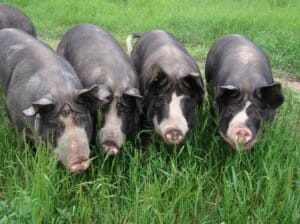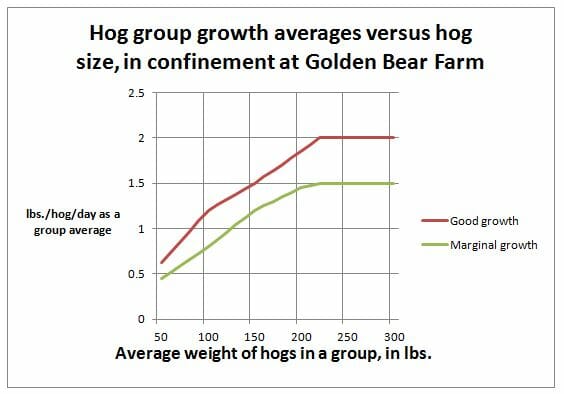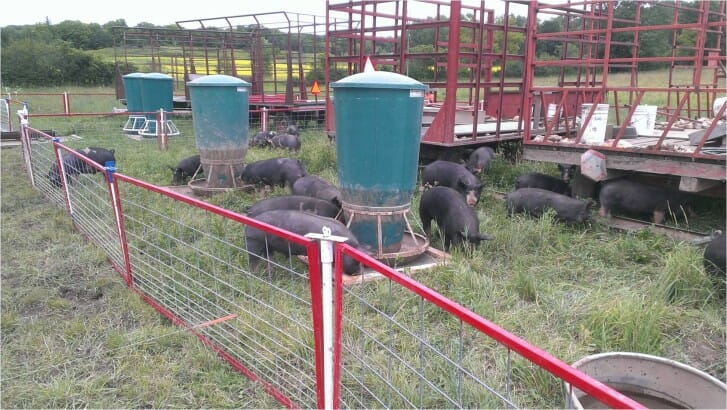Forage-Fed Pigs: Growth Rates at Golden Bear Farm

Berkshire pigs on pasture at Golden Bear Farm
The Spring 2017 issue of the Practical Farmer, includes an article titled “Forage-Fed Pig Production” highlighting Steve Deibele’s feeding practices. Steve’s a pastured pig and cattle farmer at Golden Bear Farm in Kiel, Wisconsin. He spoke at Practical Farmers’ annual conference last January on raising pigs on a forage heavy diet without the use of corn or soybeans. This blog post accompanies the newsletter article.
Average Daily Gains
“Under controlled conditions in the barn, we get our best growth rates. Pastured hogs have greater exposure to weather conditions than confined hogs which can hinder growth rates. Bad weather can degrade pastured hog comfort, impacting feeding behavior and pasture growth rates. Hot weather, cold weather, and prolonged wet weather reduce pastured hog growth rates,” explained Steve.

Average daily gains at Golden Bear Farm, during the winter, when pigs are fed indoors. The indoor ration consists of free-choice small grains, 1 to 3 lbs. apples per day, good baleage, and moderate quality hay bedding, During the grazing season, they are pastured and see more variable daily gains.
Under good conditions, group growth rates at Golden Bear Farm are better than 1.2% body weight per day for groups that have average pig weights of 100 lbs. or less. So, a 75-lb. pig would typically grow at a rate better than (75)(0.012) = 0.9 lbs. per day. A 50-lb. pig would typically grow at a rate higher than (50)(0.012) = 0.6 lbs./day, and a 100-lb. pig would grow better than (100)(0.012) = 1.2 lbs./day.
As pigs get larger their daily growth rate, as expressed as a percent of body weight, slows down. “Right around 200 to 220 lbs. the group growth rate for our genetics seems to top out at a little over 2 lbs. per pig per day, say, 2.1 to 2.3 lbs. per pig per day. Generally, when we hit 2.0 lbs. per pig per day in any of our big pig groups (200 lbs. or more for the average weight) then we know things are going well with those animals. It is not common for us to see group growth rates in these larger pigs to exceed 2.1 lbs. per pig per day. We almost always have numerous individual pigs that are growing well, but to get the group average that high or higher is a real challenge,” said Steve.
“What seems to happen most is we have some high-performer pigs that grow fast from little onward, all the way to 300+ lbs. Other pigs seem to grow more slowly, and at 190 lbs. or so they really do not step up their performances. We are beginning to slaughter these slower-performers at the 225 to 260 lbs. range because they end up dedicating a much greater amount of their feed toward maintenance needs rather than growth needs. The slow-growers are expensive to feed,” added Steve.
Steve’s 2017 presentation can be found on our annual conference multimedia page.

Mobile paddock and feeders at Golden Bear Farm.
